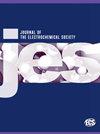Bi-Doped P2 layered Sodium-Ion Battery Cathode with Improved Cycling Stability
IF 3.3
4区 工程技术
Q2 ELECTROCHEMISTRY
引用次数: 0
Abstract
P2-phased layered oxide materials have been extensively studied as cathode material for sodium-ion batteries due to their high capacities and ionic conductivities, making them promising for large-scale applications. Additionally, manganese-based compounds, with their low cost and high capacity, have attracted significant attention in recent years. However, challenges remain regarding durability issues and related structural instability caused by the Jahn-Teller effect induced by Mn3+ ions formed during the cycling process in these materials, which causes manganese dissolution during use. In this study, we introduce a cathode composition of Na0.8Mn0.75Fe0.2Al0.05O2 and show that bismuth doping enhances the structural stability of the cathode material during electrochemical cycling. Electrodes with varying levels of bismuth doping were compared in half-cell configurations; material with 1% bismuth doping demonstrated outstanding stability, retaining 95.8% capacity after 200 cycles at a 0.2 C rate through the full potential range. dQ/dV analysis shows that bismuth doping effectively suppresses the excess Mn redox, which could otherwise deteriorate the cathode structure. As a proof of concept, Bi-doped materials were implemented in full cells paired with hard carbon that exhibited much better stability than those without bismuth doping. Lastly, the moisture and air stability of the bismuth-doped electrode were tested, demonstrating good stability.提高循环稳定性的双掺杂 P2 层钠离子电池阴极
作为钠离子电池的阴极材料,P2 相层状氧化物材料因其高容量和离子传导性而被广泛研究,使其具有大规模应用的前景。此外,锰基化合物成本低、容量高,近年来也引起了广泛关注。然而,这些材料在循环过程中形成的 Mn3+ 离子引起的贾恩-泰勒效应(Jahn-Teller effect)会导致锰在使用过程中溶解,从而引起耐久性问题和相关的结构不稳定性问题,这些挑战依然存在。在本研究中,我们引入了一种 Na0.8Mn0.75Fe0.2Al0.05O2 的阴极成分,并证明铋掺杂可增强阴极材料在电化学循环过程中的结构稳定性。在半电池配置中比较了不同铋掺杂水平的电极;铋掺杂率为 1%的材料表现出卓越的稳定性,在 0.2 C 速率下进行 200 次循环后,在整个电势范围内保持了 95.8% 的容量。dQ/dV 分析表明,铋掺杂有效抑制了过量锰的氧化还原,否则会使阴极结构恶化。作为概念验证,掺铋材料与硬碳(hard carbon)配对用于全电池,其稳定性比未掺铋的电池要好得多。最后,对掺铋电极的湿度和空气稳定性进行了测试,结果表明其稳定性良好。
本文章由计算机程序翻译,如有差异,请以英文原文为准。
求助全文
约1分钟内获得全文
求助全文
来源期刊
CiteScore
7.20
自引率
12.80%
发文量
1369
审稿时长
1.5 months
期刊介绍:
The Journal of The Electrochemical Society (JES) is the leader in the field of solid-state and electrochemical science and technology. This peer-reviewed journal publishes an average of 450 pages of 70 articles each month. Articles are posted online, with a monthly paper edition following electronic publication. The ECS membership benefits package includes access to the electronic edition of this journal.

 求助内容:
求助内容: 应助结果提醒方式:
应助结果提醒方式:


